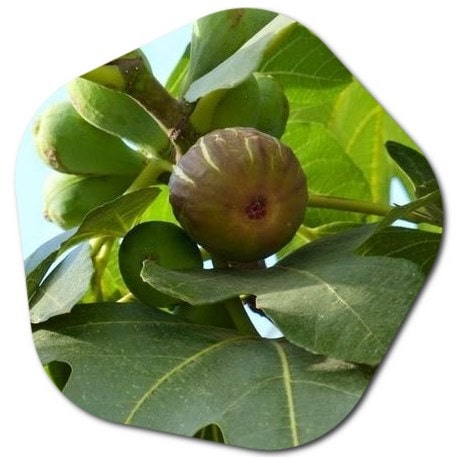The term “milk of a fig” refers to the white sap or latex that oozes from the stem or leaves of a fig tree when it is cut or injured. This milky substance contains enzymes called ficin, which are proteolytic enzymes that break down proteins.
The milk of a fig has been used for various purposes:
- Culinary Uses: The milk of a fig has been traditionally used in some cuisines as a meat tenderizer. It can be used to marinate tough cuts of meat or as an ingredient in marinades or sauces to help break down proteins and enhance the tenderness of the meat.
- Medicinal Uses: Ficin, the enzyme found in fig milk, has been used in traditional medicine for its potential therapeutic properties. It is believed to have anti-inflammatory and antimicrobial effects and has been used in topical treatments for skin conditions like warts, corns, and calluses.
- Digestive Aid: Ficin has also been used as a digestive aid. It is believed to assist in the digestion of proteins by breaking them down into smaller, more easily digestible components. Some traditional remedies suggest consuming fig milk or extracts to aid in digestion.

It’s important to note that the sap or milk of a fig tree can cause skin irritation or allergic reactions in some individuals, so caution should be exercised when handling or using it. It is always advisable to consult with a healthcare professional or a trained herbalist before using any natural remedies.
How do you collect fig milk?
To collect fig milk, you can follow these steps:
- Identify the source: Look for a healthy and mature fig tree. The milky sap is commonly found in the stems, branches, or leaves of the tree.
- Prepare the tools: Wear gloves, as the sap can cause skin irritation in some people. You may also need a clean, sharp knife or pruners to make a small incision in the tree.
- Select a stem or leaf: Choose a healthy stem or leaf from the fig tree. Make sure it is not damaged or diseased.
- Make an incision: Gently make a small cut or incision in the stem or leaf, preferably near the base of the chosen plant part. Avoid making a deep or large cut that could harm the tree.
- Collect the sap: Allow the sap to flow out naturally from the incision. It should start oozing out as a milky liquid. You can collect it by holding a clean container or bowl underneath the incision to catch the dripping sap.
- Handle with care: Take precautions not to touch the sap with your bare hands to avoid any skin irritation or allergic reactions.
- Store or use the milk: Transfer the collected fig milk into a suitable container, such as a glass jar. If you intend to use it immediately, keep it refrigerated. Otherwise, it’s recommended to freeze the milk for longer storage.
Remember to be mindful of the tree’s health and not to harm it excessively when collecting the sap. Additionally, if you plan to use fig milk for medicinal purposes, consult with a healthcare professional or an expert in herbal remedies to ensure proper usage and dosage.
Is fig milk good for skin?
Fig milk, also known as fig sap or latex, is not typically recommended for direct application on the skin. The sap contains enzymes, such as ficin, that can cause skin irritation, especially in individuals with sensitive skin. It may lead to redness, itching, or allergic reactions in some people.

However, it’s important to note that certain skincare products or treatments might incorporate processed or refined forms of fig extracts or fig-derived ingredients, which are different from raw fig milk. These products undergo specific processing methods to remove or neutralize the enzymes that can cause skin irritation.
Fig extract or fig-derived ingredients can be found in some skincare products due to their potential benefits. They are often included for their moisturizing, antioxidant, and soothing properties. They may help hydrate the skin, provide anti-aging effects, and promote a healthier complexion.
When considering skincare products containing fig extracts or ingredients, it’s advisable to carefully read the product labels, conduct patch tests on a small area of skin to check for any adverse reactions, and consult with a dermatologist if you have any specific concerns or sensitivities.
As always, it’s crucial to prioritize individual skin type, allergies, and consult with a skincare professional or dermatologist before incorporating any new product into your skincare routine.
Can I drink fig milk?
No, it is not recommended to drink raw fig milk or consume it directly. The milk or sap of a fig tree contains enzymes, such as ficin, which can cause digestive discomfort or allergic reactions in some individuals. Why is fig milk used? The benefits and harms of fig milk >>
Fig milk is known for its proteolytic properties, meaning it can break down proteins. In traditional medicine, it has been used as a meat tenderizer and as a digestive aid. However, consuming raw fig milk can potentially lead to digestive issues, including stomach upset, diarrhea, or abdominal pain.
If you are interested in incorporating figs into your diet, it is generally safer and more common to consume ripe fig fruits, which are sweet and can be eaten fresh or dried. They are a good source of dietary fiber, vitamins, and minerals. You can enjoy figs as a snack, use them in recipes, or add them to smoothies, salads, or baked goods.
If you are seeking specific health benefits or have concerns about using figs or fig-derived products for medicinal purposes, it’s advisable to consult with a healthcare professional, nutritionist, or herbalist who can provide personalized guidance based on your individual needs and health status.
What is fig milk?
When a fig tree is cut or injured, it releases a milky sap or latex, which is sometimes referred to as “fig milk” colloquially. This sap contains enzymes, such as ficin, and can have various uses, as mentioned earlier.
However, it’s important to note that this milky sap from the fig tree is not meant for consumption as a beverage or drink. It is typically used for culinary and medicinal purposes as described earlier, but it is not intended for direct consumption in the same way as regular milk.
Known benefits of fig milk
You can use fig milk to relieve pain when babies experience ear pain. Fig milk helps heal warts that occur on the skin. Dryness and cracking may occur on the heels. Fig milk heals dryness and cracking in the heels. Helps reduce skin blemishes. It provides the elimination of parasites that usually occur in the intestine and ear. Reduces bleeding gums. It is good for eye health.
Is fig milk harmful?
As with every natural product, care should be taken in the use of fig milk. If fig milk is used excessively often, it can cause skin problems. If milk is obtained from an unripe fig, this fig milk can cause mouth sores. Fig milk can be found on the market with fake and additives. Therefore, you should make sure that the fig milk is natural when you buy it. Why is fig milk used? The benefits and harms of fig milk >>

Fig milk…
Pingback:What are the benefits of fig milk for vitiligo?